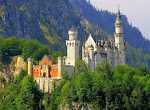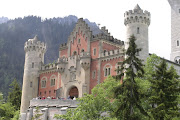Neuschwanstein Castle, Schwangau, Germany
Neuschwanstein Castle, the most beautiful castle in the world is a 19th-century Romanesque Revival palace on a rugged hill above the village of Hohenschwangau near Füssen in southwest Bavaria, Germany.
The palace was commissioned by Ludwig II of Bavaria as a retreat and as an homage to Richard Wagner.

The Throne Hall was a later addition to the plans and required a steel framework.The palace complex is entered through the symmetrical Gatehouse flanked by two stair towers. The eastward-pointing gate building is the only structure of the palace whose wall area is fashioned in high-contrast colours; the exterior walls are cased with red bricks, the court fronts with yellow limestone. The roof cornice is surrounded by pinnacles.
Neuschwanstein Castle, the most beautiful castle in the world is a 19th-century Romanesque Revival palace on a rugged hill above the village of Hohenschwangau near Füssen in southwest Bavaria, Germany.
The palace was commissioned by Ludwig II of Bavaria as a retreat and as an homage to Richard Wagner.

The palace was intended as a personal refuge for the reclusive king, but it was opened to the paying public immediately after his death in 1886. Since then over 60 million people have visited Neuschwanstein Castle. More than 1.3 million people visit annually, with up to 6,000 per day in the summer. The palace has appeared prominently in several movies.
The palace was erected as a conventional brick construction and later encased in various types of rock. The white limestone used for the fronts came from a nearby quarry. The sandstone bricks for the portals and bay windows came from Schlaitdorf in Württemberg. Marble from Untersberg near Salzburg was used for the windows, the arch ribs, the columns and the capitals.
The Throne Hall was a later addition to the plans and required a steel framework.The palace complex is entered through the symmetrical Gatehouse flanked by two stair towers. The eastward-pointing gate building is the only structure of the palace whose wall area is fashioned in high-contrast colours; the exterior walls are cased with red bricks, the court fronts with yellow limestone. The roof cornice is surrounded by pinnacles.
Neuschwanstein is a global symbol of the era of Romanticism. The palace served as a model for the Sleeping Beauty Castle of Disneyland and became a location for films such as Helmut Käutner's Ludwig II (1955), Luchino Visconti's Ludwig (1972) and Chitty Chitty Bang Bang (1968). Today, with 1.3 million visitors per year Neuschwanstein is one of the most popular tourist destinations in Europe. For security reasons the palace can only be visited during a 35-minute guided tour. There are also special guided tours that focus on specific topics. In the peak season from June until August, Neuschwanstein has up to 6000 visitors per day, and guests without advance reservation may have to wait several hours. Ticket sales are processed exclusively via the ticket centre in Hohenschwangau. As of 2008, the total number of visitors was more than 60 million. In 2004, the revenues were booked as €6.5 million.

















0 comments:
Post a Comment